How To Clean Composite Decking The Ecoxplank Right Way?
[seopress_breadcrumbs]
Cleaning and maintaining the WPC deck (Composite Decking) is an important step in ensuring its long-term beauty and longevity.
This guide is designed to give you the key steps on how to clean composite bridge panels, covering a comprehensive cleaning process that will ensure your deck stays beautiful and comfortable for years to come.
1. Clean Your Composite Deck
Composite decks offer little or no maintenance compared to traditional timber decks. But you still need to take care of your composite deck, which will make your composite deck look brand new and clean and hygienic.
Cracks in the composite deck can harbor dust and dirt, breeding bacteria and affecting health. Food residue and dirt in the cracks, coupled with the wet environment after the rain, is easy to breed bacteria and microorganisms, as well as attract scavengers and insects, which pose a threat to health, especially in homes with pets and children.
But you can rest assured that this attachment will not affect the life of your composite deck. It will only affect health, such as: the dust attached to the surface will enter the respiratory tract and affect the air quality of life.
Below are some complete cleaning solutions to help keep your composite deck looking great and ensure little maintenance for years to come. And provide you with a comfortable space to be healthy, relax and enjoy your deck and garden.
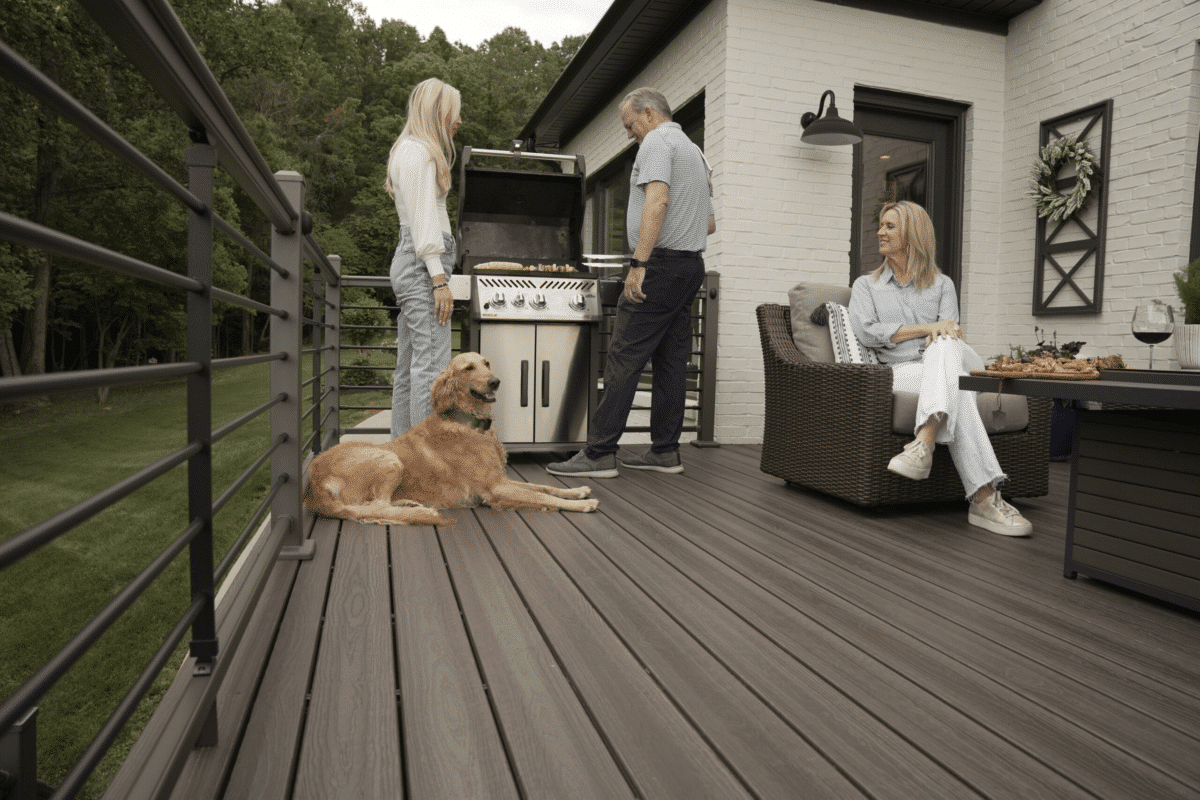
2. What You Need to Know before Cleaning Your Composite Deck?
A. Deck Cleaning Solutions and Cleaning Tools and Materials Required
We’ve put together the right materials and tools for your daily maintenance and deep cleaning. If you are doing routine maintenance, you only need a simple cleaning tool, as shown in the picture:
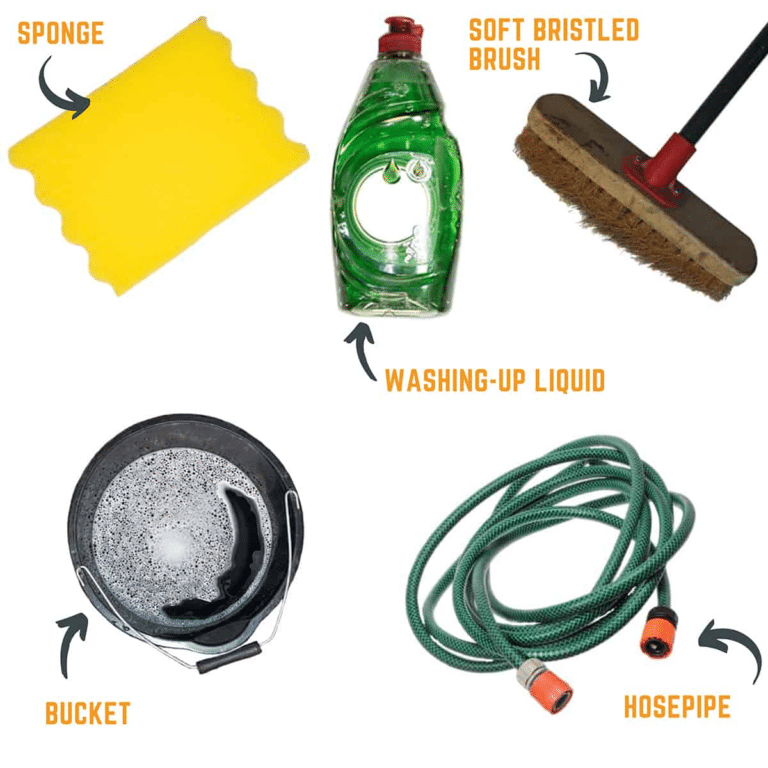
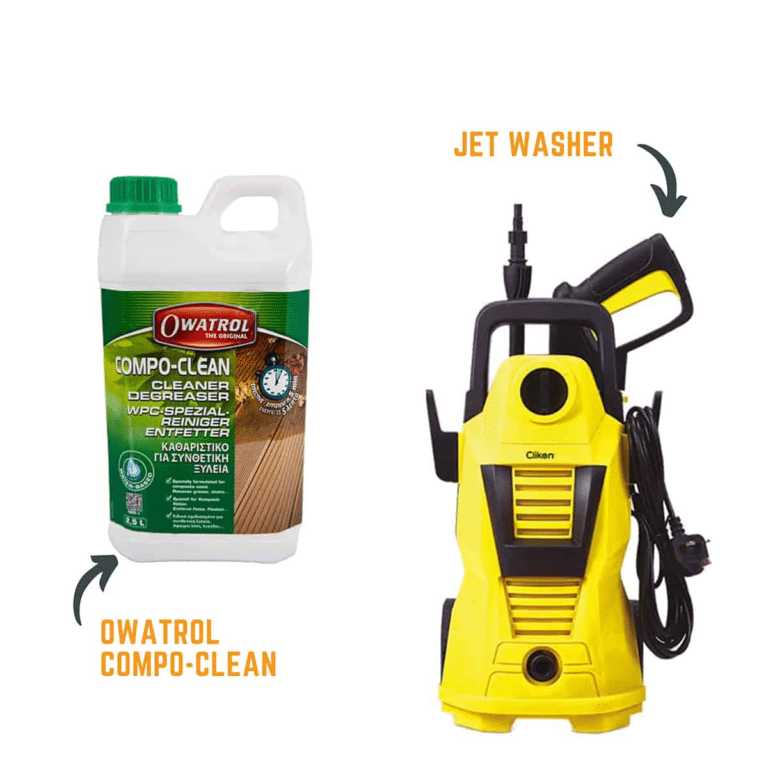
| Routine/Deep Cleaning | Tools/Cleaning Agents | Main Purpose | Applicable Scenarios | Precautions |
| Routine Maintenance | Soft bristle broom or blade hair dryer | Remove surface debris, such as fallen leaves and dust. | Preparation before cleaning. | Avoid using a stiff brush to avoid scratching the deck. |
| Soft bristle brush | Clean surface dirt and remove fine particles. | Daily cleaning, removal of general stains. | For stubborn stains, it may be necessary to use with a cleaner. | |
| Mild dishwashing liquid (ammonia-free) | Remove oil, food debris, etc. | Daily cleaning, use with soft brush. | Avoid using cleaners containing ammonia to avoid damaging the deck. | |
| Deck brush | Deal with stubborn stains, clean grain particles, deep dust. | For stubborn stains, such as oil, mold, etc. Deep cleaning, dealing with dirt in the texture | Avoid using metal brushes to avoid scratching the deck surface. | |
| Warm water | Rinse the cleaner and dilute the cleaning solution to remove dirt. | All cleaning processes | The water temperature should not be too high to avoid burns. | |
| Spray pipe | Rinse the cleaner to remove the dirt. | Light to moderate cleaning, suitable for daily maintenance | The pressure of the high pressure washer should not be too large, and the foam can be washed clean. | |
| Deep cleaning | Simple Green composite deck cleaner | Cleaning agent designed for composite deck, strong effect. | Treat stubborn stains and clean grain particles. | Use according to product instructions to avoid excessive dilution. |
| Dawn Power Cleaning Spray | As a substitute for Dawn detergent, the cleaning effect is better. | Treat stubborn stains. | Avoid spraying directly on the deck surface to avoid foaming. | |
| Baking soda | Removes stubborn stains, odors, neutralizes acidic substances. | Treat stubborn stains such as oil and burn marks. | It works better when mixed with vinegar. | |
| vinegar | Eliminate mold, algae | Deal with mold growth. | A 1:1 ratio of vinegar to water. Use after dilution to avoid direct contact with strong vinegar corrosion deck. | |
| High pressure washer | Deep cleaning, large area cleaning | Stubborn stains, seasonal maintenance | The water pressure should not exceed 1500 PSI, and the nozzle should be kept at least 30 cm away from the deck | |
| Tips: 1. Avoid using bleach and strong acid/alkali cleaners: these strong corrosive chemicals can damage the composite deck. 2. Regular maintenance: Clean and wash the deck every 1-3 months to keep it beautiful and your living environment healthy. 3. Regular inspection: During the rainy or wet season, check the deck regularly for standing water or mold growth in the crevices. | ||||
B. How to Choose the Right Type of Flooring Cleaner for Your WPC Deck?
When cleaning the composite deck, it is necessary to choose according to the cleanliness and durability of the deck.
A variety of cleaners are available depending on cleaning needs and deck conditions. We will tell you what is the best composite deck cleaner for you.
Here is a comparison of composite deck cleaners:
| Detergent type | Main ingredients/characteristics | Application situation | Matters needing attention | Additional advice |
| Commercial composite deck cleaner | Special formulations, mild cleaning ingredients (e.g. surfactants, thickeners, etc.) | Designed for composite deck materials, regular maintenance, moderate stains, daily cleaning | Choose environmentally friendly products, follow the manufacturer’s instructions, avoid excessive use, and ensure that they are not harmful to the surrounding environment and plants. | Can be used for all kinds of composite flooring, with pertinence.Simple Green |
| Homemade natural cleaner (baking soda + vinegar) | Baking soda: decontamination and deodorization; Vinegar: bactericidal, mildew free, natural antibacterial | Stubborn stains, oil stains, mold | The vinegar should be diluted (1:1 ratio of water to vinegar); Avoid use at high temperatures; Rinse thoroughly after use to prevent residue. | Economical and environmentally friendly, suitable for DIY. |
| Mild Liquid dish soap (ammonia-free) | surfactant | Daily and light cleaning, suitable for regular maintenance. | Choose ammonia – and phosphorus-free products such as Simple Green. | Suitable for most laminate flooring, mild and non-irritating. |
| Special deck mold remover | Bleach, fungicide | Specially designed to remove mold and algae, high humidity and serious problems of mold | Wear protective equipment when using; Let it sit for 10-15 minutes after spraying, then scrub and rinse. Avoid direct contact with skin. | Strong pertinence, the effect is remarkable. For example: Mold Armor:Mold Armor |
| Non-corrosive strong cleaner | Strong decontamination ingredients (such as alkaline cleaners) | Deep cleaning, stubborn stains, paint and coatings | Avoid using bleach and rinse thoroughly. Pay attention to protection. | Suitable for extreme stains, use with caution. |
| Cleaning tips: 1. Avoid chlorinated or bleached cleaners: these ingredients can damage the surface and color of the composite deck. 2. Test on a small scale: Before using the new cleaner, test it in an inconspicuous place to ensure that it will not cause discoloration or damage to the deck. | ||||
C. How to Choose the Right Composite Deck Cleaner?
- Light daily cleaning: If you are dealing with dust and light stains daily maintenance. Warm water and mild liquid dish soap will do, do not need to buy special detergent.
- Stubborn stains and mold: Use a mixture of baking soda and vinegar.
- Deep cleaning: Choose an environmentally friendly commercial composite deck cleaner to ensure that the product is suitable for use on composite surfaces.
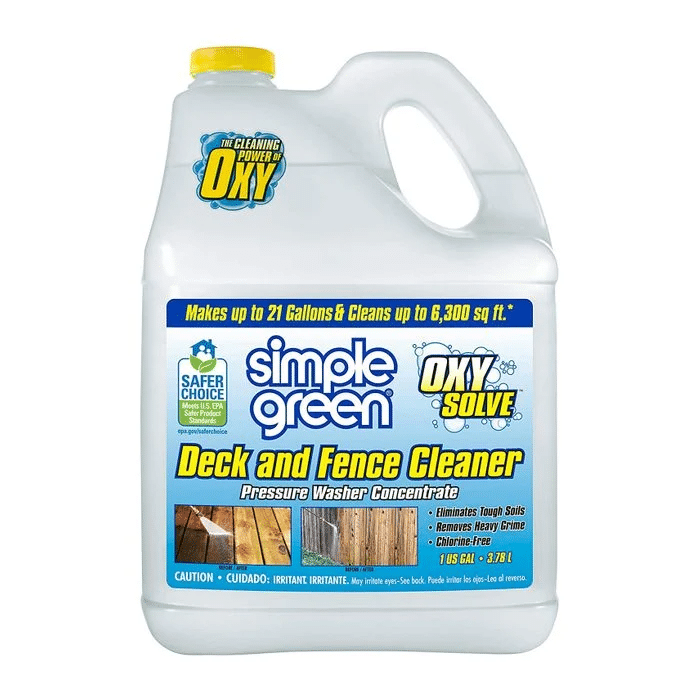
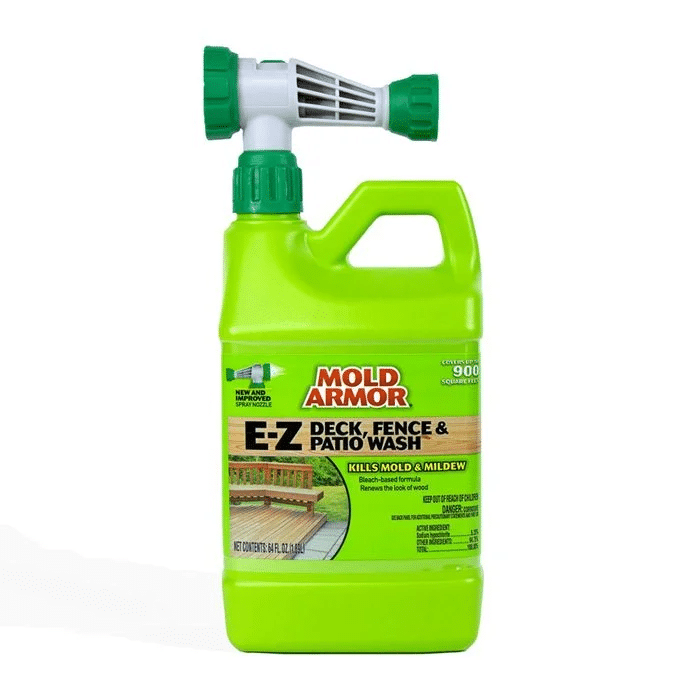
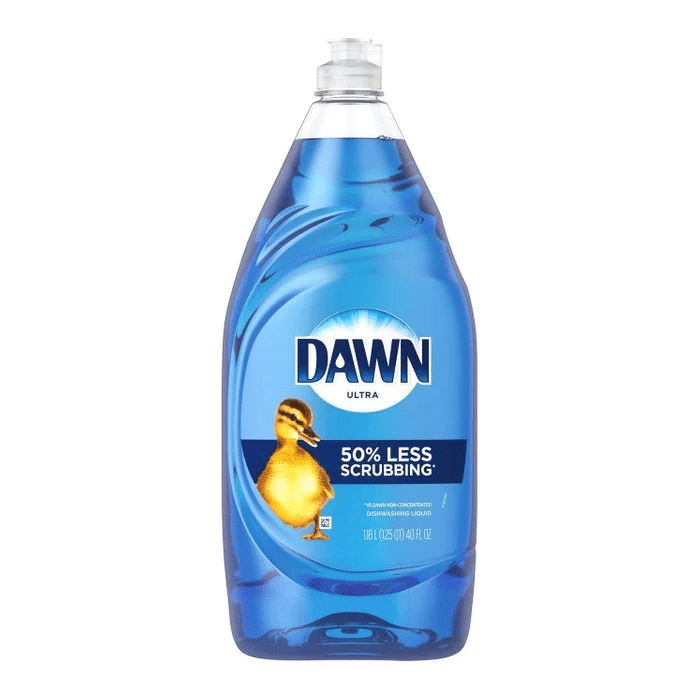
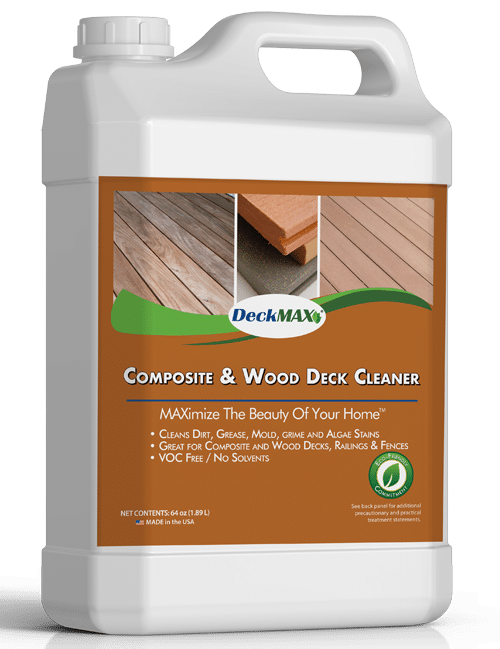
3. How to Clean Composite Decking in 5 Easy Steps?
You can watch the video of cleaning the composite deck below, while Ecoxplank also put together the specific steps for you:
1. Prep the WPC Deck (Remove everything)
Clear the deck of any furniture, plants, or other objects.
Sweep the deck to remove loose dirt and debris. Use a broom or blade hair dryer to clean the deck surface of fallen leaves, dust and other loose debris. Pay attention to cleaning the accumulation in the crevices, as these can cause water accumulation and mold growth.
Before cleaning the composite deck, all furniture, fish tanks, plants and other items on the deck need to be removed first to ensure that the cleaning process is not disturbed. Next, use a broom or blade hair dryer to thoroughly sweep the deck to remove fallen leaves, dust and other debris. Pay special attention to cleaning the gaps in the floor, because these places are prone to water and mold.
With this preparation step, a good foundation can be laid for subsequent deep cleaning, ensuring that the deck remains clean and safe.
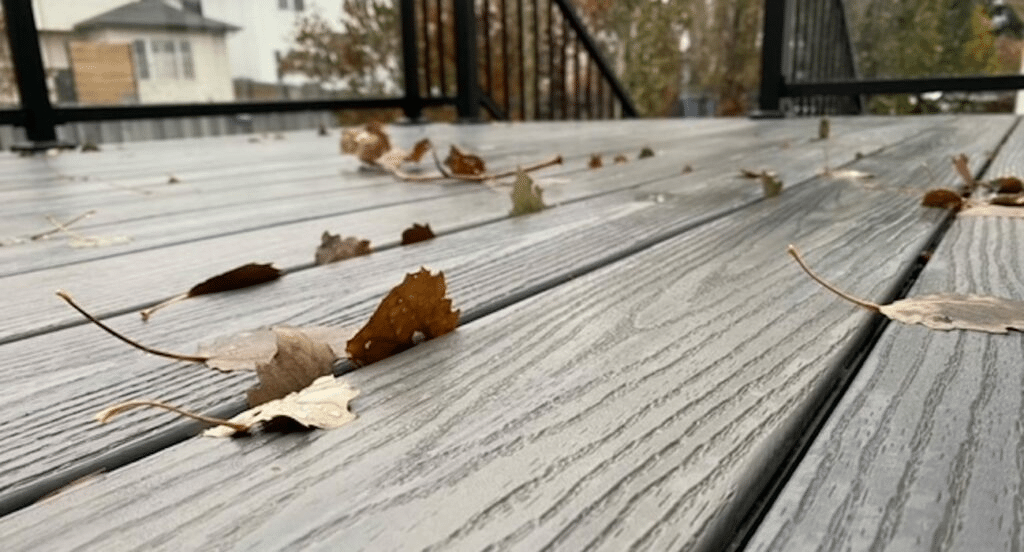
2. Clean the Composite Deck
After removing all obstructions and making an initial sweep, we need to clean the deck more deeply.
Using a soft brush or a deck brush dipped in a diluted mild cleaner (such as ammoniac-free dish soap or a special WPC deck cleaner), gently scrub the deck surface and, for gap cleaning, sweep along the texture of the deck.
For stubborn stains, you can dip the brush into the detergent and scrub the stain repeatedly. Be careful not to use too much force when brushing, and avoid using metal brushes to avoid damaging the deck surface.
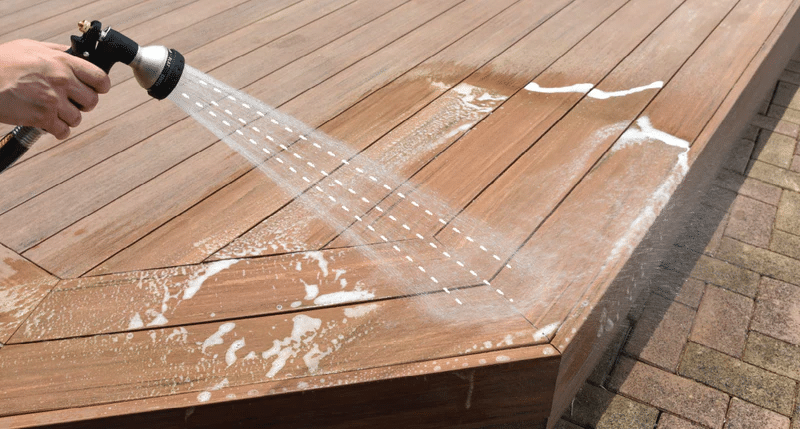
3. Pre-Rinse the WPC Deck
Before performing a thorough cleaning, gently rinse the entire deck surface with a spray hose to remove floating ash and slight stains on the surface, while rinsing, ensure that the water evenly covers the deck, paying special attention to gaps and corners to prevent dirt residue. This helps prepare for the next deep cleaning.
If you choose to use a pressure washer, ensure that the nozzle is at least 30 cm away from the deck surface to avoid scratching or damaging the deck due to high water pressure. This step can effectively loosen surface dirt, making subsequent scrubbing and cleaning solutions easier to penetrate and work.
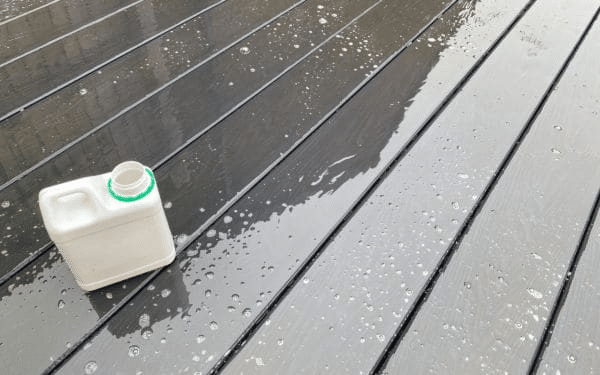
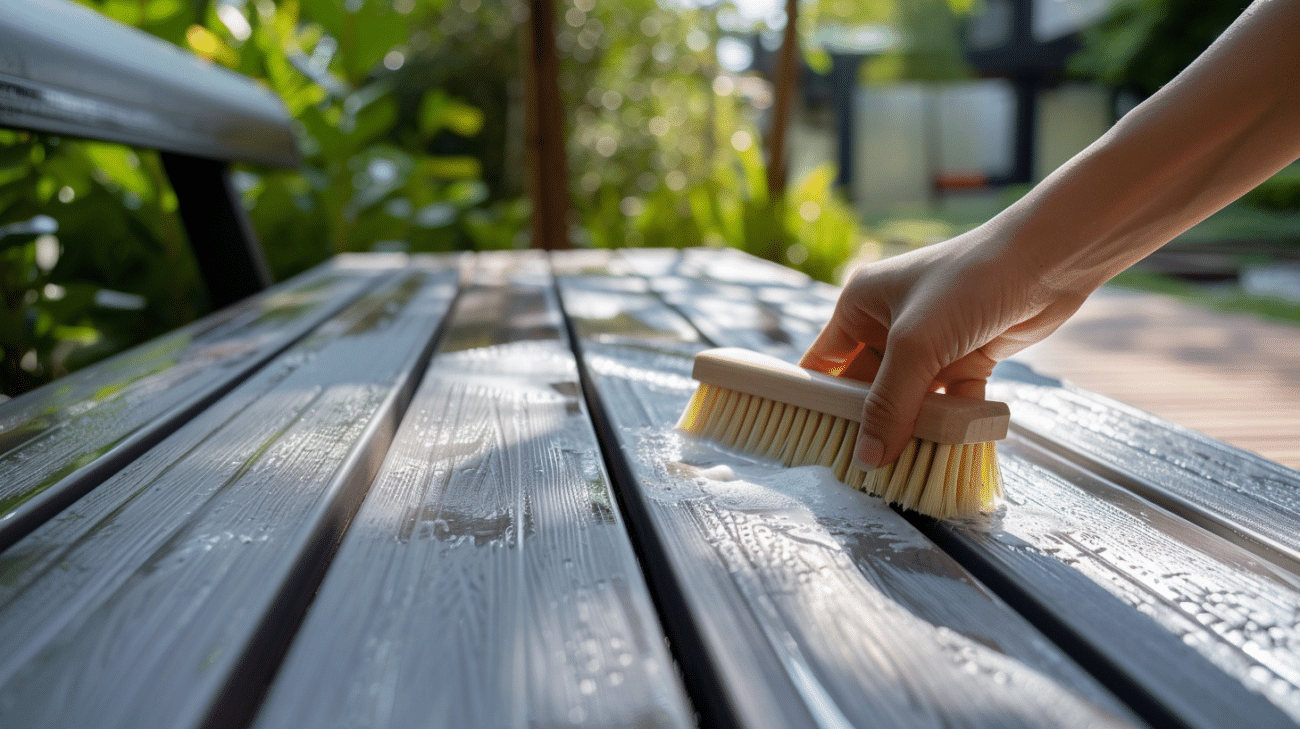
4. Apply Composite Deck Cleaner
- According to the product instructions, mix a neutral cleaner or special composite deck cleaner with warm water to make a cleaning solution and evenly apply it to all deck surfaces, especially areas with a lot of dirt.
- Make sure to choose neutral cleaners or cleaning products designed for composite decks, and avoid using products containing bleach or strong acid/alkali ingredients that can damage the composite deck surface and cause fading or corrosion.
- When applying, a soft brush can be used to help push the cleaner deeper into the texture of the deck for better cleaning of stubborn stains.
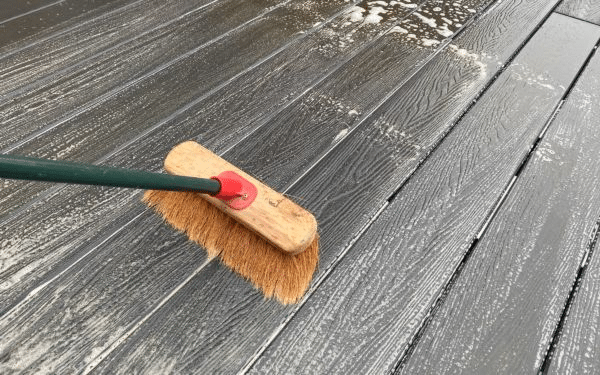
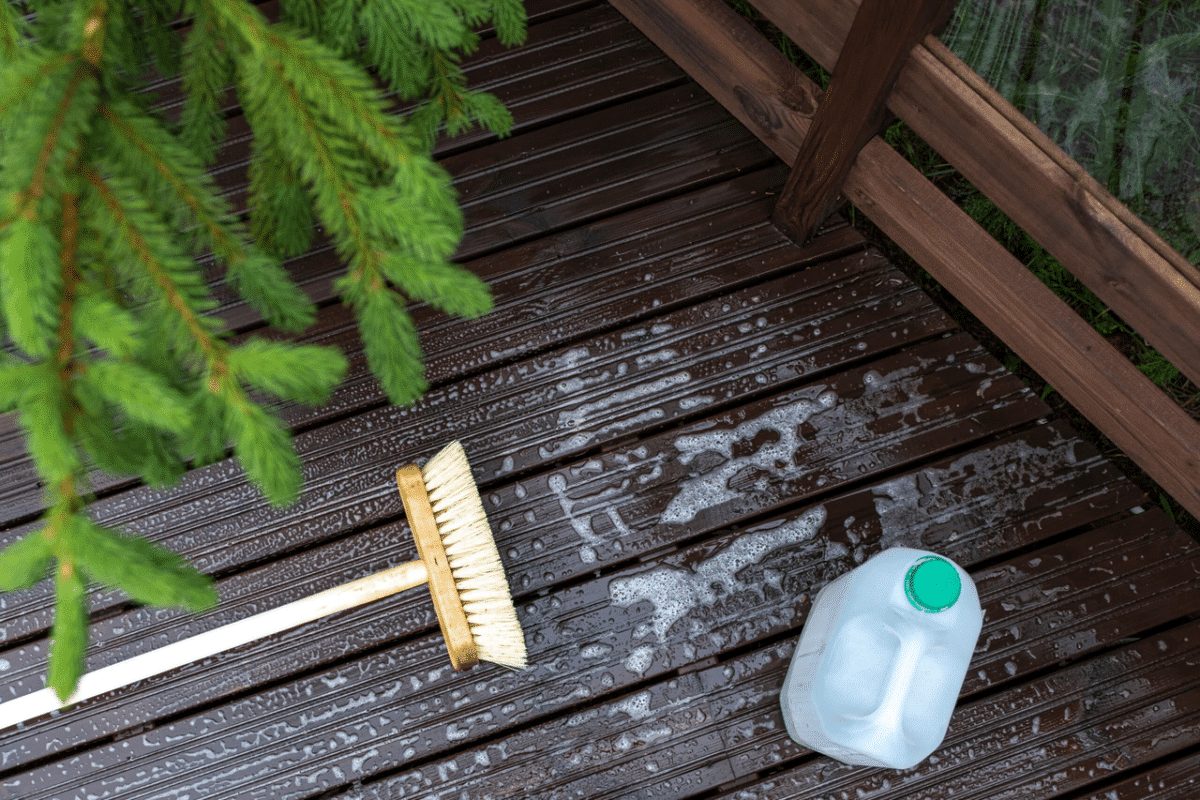
5. Rinse Your Composite Deck Thoroughly
After applying the cleaning solution to the deck surface, scrub gently with a soft brush or deck cleaner to ensure that the cleaner penetrates deep into the deck texture and effectively removes dirt. For stubborn stains or oil stains, you can focus on the local area for repeated scrubbing in order to completely remove the residue.
Once you have finished brushing, rinse the deck thoroughly with a spray hose or a low pressure pressure washer to ensure that the cleaner is completely washed away and to avoid any residue that could cause the surface to slip or color to deteriorate.

Deck Cleaning Tips:
- Consider using composite deck brightener to restore the natural shine of the deck
- Avoid harsh chemicals, such as cleaners containing bleach or strong acids
- Avoid using metal brushes: Metal brushes can scratch the deck surface, use a soft brush.
- Stay away from hard water spots: Dry the deck quickly after washing to avoid water spots.
- Regular maintenance: Regular cleaning and washing of the deck every 1-3 months, in the rainy season or wet season, check the deck for water or mold, timely treatment. Common problems affecting outdoor WPC decking.
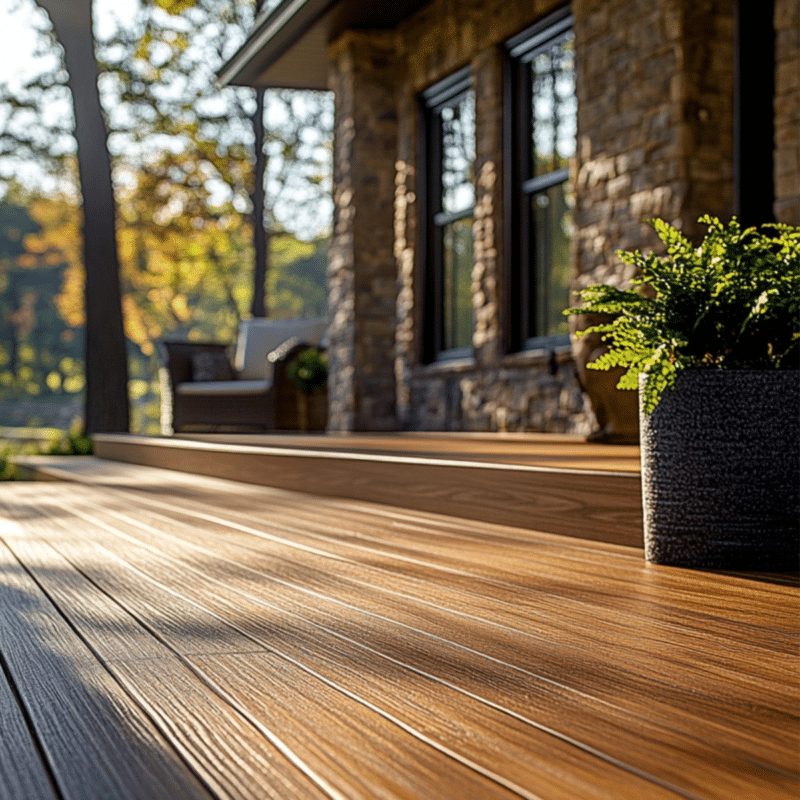
4. Common Problems When Cleaning Composite Decks
Here are the common problems encountered by your composite deck, especially how to deal with different stains, this form can help you quickly find your corresponding problems and corresponding solutions, so as to effectively maintain the appearance and performance of composite deck.
| Q&A | solution |
| Mold and mildew | Use a special anti-mold cleaner to evenly spray the area with mold, let it sit for 10-15 minutes, brush with a soft brush, and rinse thoroughly with water. |
| Beverage and food stains | Clean up spills immediately with a damp cloth or sponge, then rinse with mild liquid dish soap and warm water. If the stain is stubborn, mix baking soda with water to make a paste, scrub and rinse after applying. Avoid stains that stay on for a long time. The sooner you clean them, the easier it is. |
| Oils and greases | Apply baking soda and warm water mixture to the stain and let sit for a few minutes before scrubbing. For stubborn oils, you can use a mild special oil cleaning agent, and finally rinse thoroughly. |
| Ice and snow | Use plastic shovels to gently remove snow and avoid metal shovels to avoid scratching the deck. For ice, salt or another safe snowmelt agent can be used to speed up the melting process. |
| Pollen and seeds | Sweep the deck with a soft broom or use a blade hair dryer. Wash the deck regularly to prevent pollen buildup that can cause stains and allergens. |
| Hard water stain | Dry the deck immediately after washing with a clean absorbent towel or soft cloth to avoid hard water spots left by water stains. For water stains that have formed, use white vinegar or special detergent to spray on the stain, let it sit for a few minutes, brush with a soft brush, and then rinse off with water. |
| Color fading | Clean the deck regularly to prevent dirt buildup, and consider using a specialized composite deck protectant to restore color and shine. |
| Concrete, cement, mortar or plaster dust | Clean the dust from the surface with a dry brush, then rinse the deck with warm water and a mild cleaner, gently scrub the surface, and rinse thoroughly. Avoid using water cannons to prevent damage to the deck. |
| Chalk line | Wipe gently with a damp cloth or sponge, clean with mild soapy water if necessary, and rinse thoroughly. For stubborn chalk residue, apply with baking soda paste and scrub. |
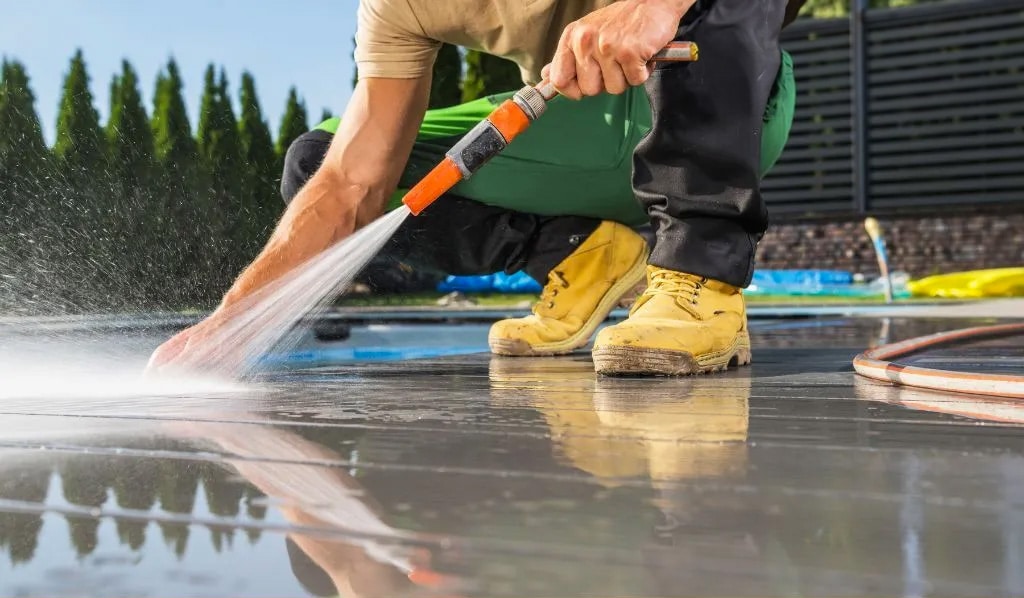
FAQ on Composite Decking
How To Pressure Wash Composite Decking?
When using a pressure washer to clean a composite deck, it is recommended that the water pressure be controlled below 1500 PSI to avoid damaging the deck surface. Keep the nozzle at least 30 cm away from the deck surface and clean it in the direction of the deck texture to avoid strong water directly impacting the seam or texture.
How to Clean Composite Decking Without Pressure Washer?
You can use a soft broom or blade hair dryer to remove debris from the surface. Mix a mild dish soap solution with warm water. Stubborn stains can be treated with a mixture of baking soda and vinegar, and finally rinse off with a spray hose to ensure that no detergent remains.
Can I Use White Vinegar to Clean Composite Decking?
Yes, vinegar is a safe, natural cleaner that is especially good for removing mold and algae. Dilute the vinegar with water in a ratio of 1:1 and apply it to the area that needs cleaning. Let it sit for 10-15 minutes, then brush gently with a soft brush and rinse off with water.
Can Household Cleaners Be Used to Clean Composite Decking?
Yes, but choose a mild cleaner, such as liquid dish soap, that does not contain ammonia or bleach. Make sure the cleaner is safe for composite surfaces and rinse thoroughly after cleaning to remove residue.
What Should Not Be Used on Composite Decking?
Avoid using the following products:
- Cleaners containing bleach (may cause discoloration or damage to the surface).
- Strong acid/alkali cleaners (may erode the surface coating). - Metal brush or stiff brush (may scratch surfaces).
- High pressure water flows over 1500 PSI.
- Cleaners containing bleach (may cause discoloration or damage to the surface).
- Strong acid/alkali cleaners (may erode the surface coating). - Metal brush or stiff brush (may scratch surfaces).
- High pressure water flows over 1500 PSI.
Can I Use Patio Cleaners on Composite Decking?
Yes, but make sure the yard cleaner is suitable for the composite deck. Check label instructions and avoid cleansers that contain bleach or chemical compounds.
Can I Clean Composite Decking with Bleach?
It is not recommended to use bleach to clean composite decks. Bleach may cause the surface of the deck to fade and damage its protective coating. If you need to remove mold, a special deck mildew cleaner or diluted vinegar is recommended.
Can I pour boiling water on composite decking?
Pouring boiling water directly onto the composite deck is not recommended. High temperatures may damage the surface coating or structure of the deck. If cleaning is required, it is recommended to use warm rather than boiling water.
Why Are Composite Decks Easier to Clean?
Composite decks are easier to clean than traditional wooden decks, have stain-resistant and mildew resistant surfaces, and do not require regular sealing or staining. Its smooth texture design makes it difficult for dust and dirt to adhere to, and the cleaning process is very simple and low maintenance.
Is the Cleaning Solution Suitable for My Composite Deck?
Before using a specific cleaning solution, check the deck manufacturer's recommendations to ensure that the products and methods used are safe for your composite deck.
Usually, you can find this information on the manufacturer's website or in the accompanying maintenance guide. If you are not sure, you can always contact Ecoxplank to solve your problem.
Usually, you can find this information on the manufacturer's website or in the accompanying maintenance guide. If you are not sure, you can always contact Ecoxplank to solve your problem.
How Often Should I Clean My Composite Deck?
Daily maintenance is recommended to sweep and simply wash the deck every 1-3 months, and deep cleaning is recommended to clean the composite deck once or twice a year to maintain its appearance and cleanliness. During the rainy or wet season, the deck should be inspected and cleaned more frequently to prevent mold and dirt accumulation.
Get A Free Quote
Related Blog
The 6 Most Important Technical Indicators of WPC Decking
When you approach the building materials market or browse e-commerce platforms, faced with hundreds or thousands of WPC decking (compos...
Should You Source WPC Fence from China?
If you are a wholesaler or project contractor, sourcing WPC fencing from China can help you cut costs significantly.
However, not all ...
Swimming Pool WPC Deck: Complete Manufacturer Guide
As a professional WPC composite decking manufacturer, we found that 90% of swimming pool projects face common issues.These include wate...
The 6 most popular WPC gate styles
As a WPC product manufacturer in China, we have collected numerous customer requirements for WPC fence gates from projects worldwide. W...
Load more posts
Loading...

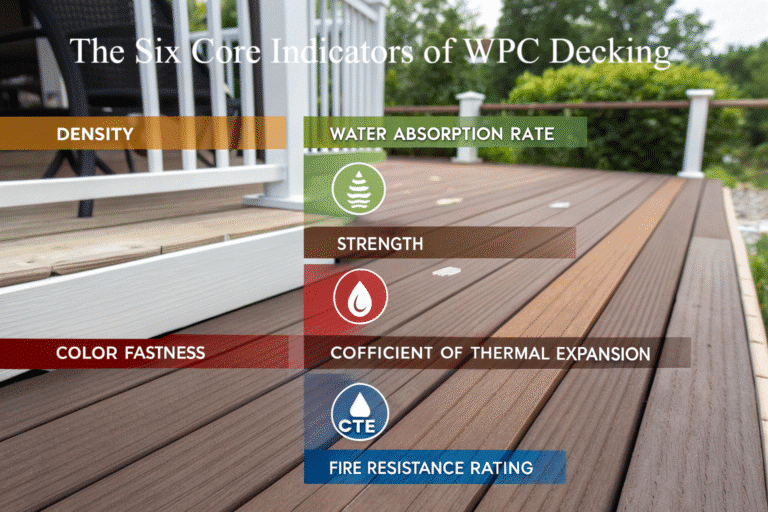

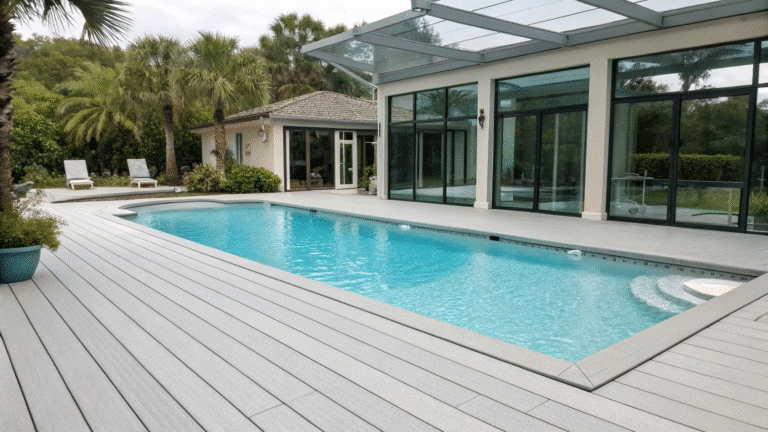
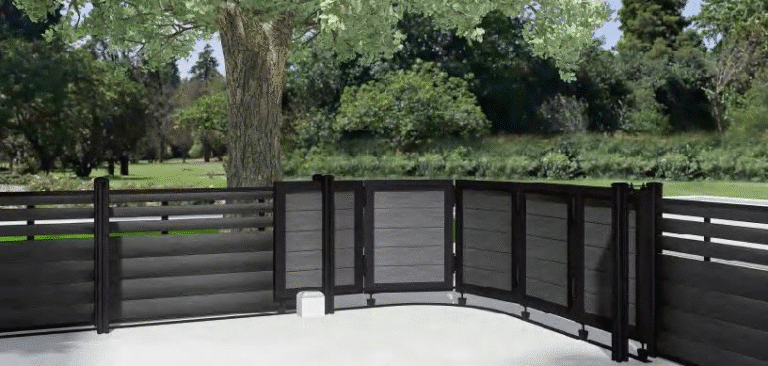
One thought on “How To Clean Composite Decking The Ecoxplank Right Way?”
Alright fellas, v788bet’s got a good vibe. I’ve had a few wins, no complaints so far. Worth a shot if you’re looking to kill some time. Check out v788bet and see for yourself